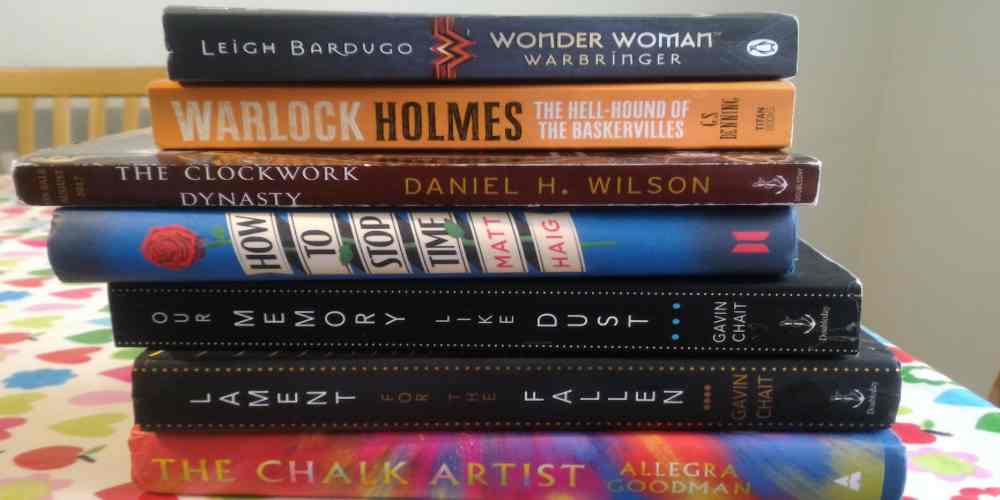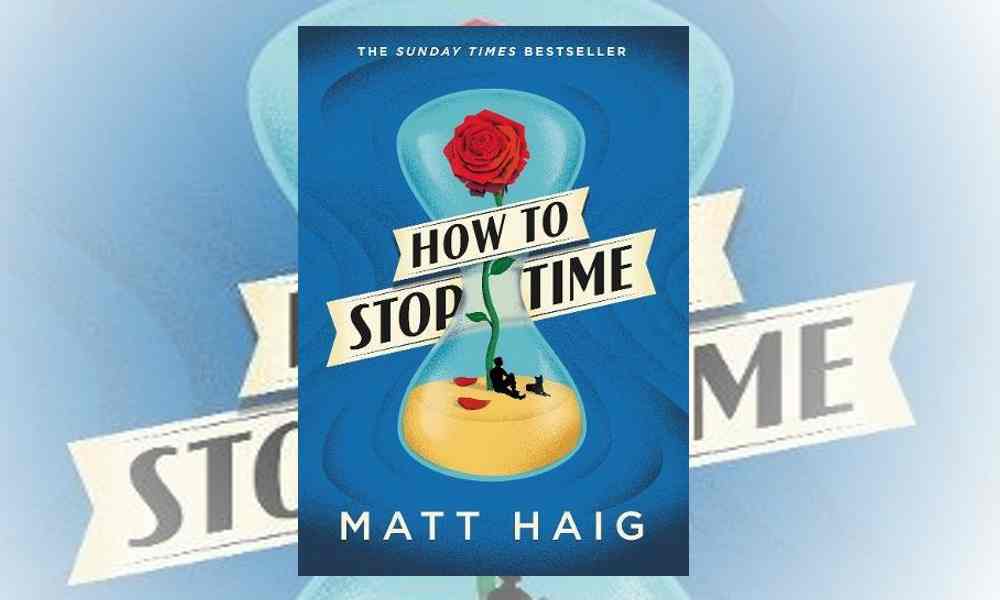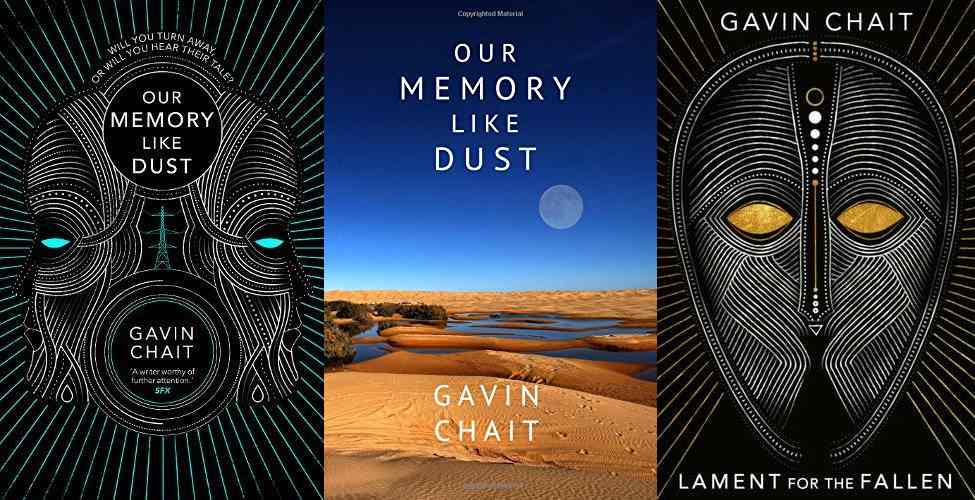
Summer has almost gone and the paper mountain stretches ever higher into the sky (well, closer to the ceiling.) Its summit will never be reached; books arrive on the doormat faster than I can read them. This is the fifth installment of my peripatetic readings and it’s been a fine couple of months. There hasn’t been a single novel I haven’t enjoyed. Read on for books by the heirs of Asimov, Adams, and Pratchett, and the first book in the DC Icons series.
 How to Stop Time by Matt Haig
How to Stop Time by Matt Haig
What is the book about?
It’s Highlander without Sean Connery or claymores.
Tom Hazard is possibly the most over-qualified history teacher in, well, history. He has been alive for centuries. Yet he only looks 41. He does age, just very very slowly. Much like Christopher Lambert, this causes him all sorts of problems.
To ameliorate this issue, Tom (or Estienne, as his Huguenot mother called him) is a member of the Albatross Society. The Society sorts out its members and tries to protect them from the pitfalls of never aging. It moves its members on every 8 years, providing them with new identities and financial security. All its members have to do in return is carry out a task, in between finishing one life and taking up the next. The jobs can be almost anything.
Another important tenet for a member of the Albatross Society is not to fall in love. You can guess what happens.
Why should you read this book?
My glib answer would be, “Because it’s a Matt Haig book.” The Humans, the story of an Alien who takes over the body of a university lecturer, is one of my favorite books of all-time. It has Douglas Adams levels of brilliance.
It’s been a while since Haig has written another adult novel, (though he has written a personal, heartfelt account of depression and a brilliant children’s book about Father Christmas,) and I’ll be honest, I approached How to Stop Time with some trepidation. What if it wasn’t as good? If you write something as good as The Humans, how do you follow it up?
I have to confess, I didn’t find that How to Stop Time reached the same heady heights as The Humans, but it is still a book that is wonderful to read. Haig is a master at dissecting the human condition. The things that make us tick; the absurdities of our lives. He is brilliant at describing the agonies and ecstasies of love. The book at its heart is a lesson on the importance of learning from the past.
If you haven’t read The Humans you should remedy that immediately. I envy you. I’d love to read that for the first time again. Otherwise, sit back with How to Stop Time and wallow in Haig’s warming prose. There is something about his examination of life that makes me feel glad to be alive. It may not be Haig’s best novel, but How to Stop Time is still a very fine read.

The Lament for the Fallen and Our Memory Like Dust by Gavin Chait
What are the books about?
Gavin Chait is a new author who writes science fiction set in Africa. The two books are twinned but not directly connected. Both draw on traditional stories and the power of storytelling to convey context, meaning, and messages to guide us in life.
The Lament for the Fallen is set a hundred or so years into the future. A vessel crashes in a West African town. When the town’s inhabitants rescue their pilot, their world is changed forever.
Off-Earth travel is not unknown in Chait’s world, so the arrival of the spaceship is unusual rather than unprecedented. This is not a first contact story. Nevertheless, the new arrival sets an unexpected series of events in motion.
As the story unfolds we also learn of a mysterious prison planet. What connection does the spacefarer have to it?
Our Memory Like Dust is set in the future, but much nearer in time than The Lament for the Fallen. Again the bulk of the novel is set in Africa. This is more of a geopolitical/environmental thriller with a sprinkling of fictional science.
The African desert is a no-man’s land, not just because of the weather but also due to a roving band of Jihadis called Ansar Dine. Their warlord effectively rules the region with fear.
In Senegal, an Englishman arrives, wanting to set up a solar farm. His goal is to supply electricity to Europe. Aiming to stop him are the Russians, who have cornered the energy market. The Russian oligarchs make huge amounts of money and they’re not about to give that up. They’re prepared to do anything to maintain their monopoly.
Realizing his dreams of supplying Europe with electricity are literally dust, Simon Adaro sells his power to the locals, and a quiet revolution begins.
Why should you read Gavin Chait?
If you’re looking for a fresh new voice with books set somewhere different to most science fiction, you should definitely give Chait a go. It probably doesn’t matter which one you begin with, though Our Memory Like Dust starts with many pages of short disjointed stories, and I found myself wondering what I’d let myself in for.
After about 50 or pages or so the book settles down, and after that it’s mesmerizing. The meld of science and its political implications feels perfect. It’s a deeply human and compassionate novel, that examines corporate business, terrorism, and the difficulties of rehoming refugees.
Laced through it is Chait’s signature device (if you can have a signature device after only two novels) of weaving oral folklore through the story. These sections bring a different quality to the rest of the narrative. They inform the wider plot and in some cases even guide the novel’s characters. Chait’s use of science and the way he predicts how it will change the way the world works is masterful.
Our Memory Like Dust is a brilliantly woven novel and portends great things for the author.
Equally good is Lament for the Fallen, a more traditional science fiction novel. I was slightly confused as the two novels share some of the same character names, though as far as I can tell, the characters are not the same people across the two books. At first, I thought Memory Like Dust was a prequel novel, but that was not the case.
Again, it’s Chait’s use of science and its sociological and human-geographic consequences that set the novels apart from other books I’ve read. That and the author’s compassion for humanity and representation of a diverse planet that makes the book such a joy to read.

The UK and US editions. I much prefer the evocative colors of the UK edition.
The Chalk Artist by Allegra Goodman.
What is the book about?
Gaming, Virtual Reality, and its effect on young lives.
What again? I hear you moan. But before you wander off for another blast on Overwatch, let me explain why you should read it.
Why should you read this book?
A few years ago, I read Allegra Goodman’s Intuition. This is an amazing fiction-about-science tale, that delves into the trial of tribulations of life as a research scientist. Its languid pace belies its razor-sharp observation, and slow heating up to a ferocious boil.
And so it is with The Chalk Artist.
On the face of it, this could have been another The Circle by Dave Eggers. I know some people love that book, but I found it patronizing and without subtlety.
The novel has a central cast of five players, who all interact to a greater or lesser degree. The lynch-pin of the novel is Collin, a chalk artist. A young man of exceptional talent, who works only in chalk. His breath-taking creations are destroyed almost immediately after they are finished.
He falls in love with Nina, an English teacher, who also happens to be the daughter of a computer billionaire. Viktor Lazare created the virtual world of EverWhen, a game played across the globe. He is head of Arkadia, the company that runs EverWhen. A much-rumored VR expansion is promised, but when will it arrive?
One of Nina’s students, Aidan, an EverWhen devotee, falls into an online relationship with a mysterious woman. His infatuation is spurred on when a mysterious box arrives on his doorstep. It’s new, cutting-edge tech that allows him to play UnderWorld, the fabled EverWhen VR expansion.
Whilst this is going on, Nina persuades Collin to take a job at her father’s company where he uses his artistic talents to create new graphics for EverWhen. Here he meets Daphne, who works in Arkadia’s social media division. Her job is to promote Everwhen. She ensnares young devotees of the game to enact guerilla stunts to gain publicity for the UnderWorld.
The Chalk Artist is an excellent portrayal of obsession in its many forms. It’s terrifying reading for parents. Aidan’s obsession with EverWhen threatens to overwhelm him and his relationship with his family, including that with his twin sister, Diana. The powerlessness Aidan’s mother feels as she tries to intervene is vividly portrayed.
Obsession for perfection drives Collin’s daily life too, in his artwork and in the attitudes of Arkadia’s overlords. Nina hopes to be a better teacher and is almost consumed by the fear of failure. In mentoring Aidan, she sees the opportunity for success, but at what cost?
There’s a fascinating juxtaposition of the impermanence of Collin’s art with the art of computer software, and with the impermanence of computer games. You can put hours of effort and skill into them, but once you’ve powered them down, what do you have?
The characters in The Chalk Artist are very strong. The whole novel hangs on the strength of their portrayal. Diana and Aidan’s family dynamic and the relationship between Collin and Nina are particularly fine. Goodman provokes great love (and hate) for her creations. As I read I was desperate for them all to come out of the book unscathed.
The Chalk Artist is an understated but absorbing novel that fascinates throughout.

Wonder Woman: Warbringer by Leigh Bardugo
What is the book about?
A teenaged Diana finds the sanctuary of her island in jeopardy after rescuing a mortal from drowning. Unbeknownst to Diana, Alia Keralis is a direct descendant of Helen of Troy. A Warbringer.
The arrival of a new Warbringer heralds a great and tumultuous time for the world. Alia literally causes fights everywhere she goes. She is being targeted by many factions, both human and divine, who wish to harness her power. Some just want her dead.
Can she and Diana overcome their differences to work out how to stop the Warbringer prophecy coming true? And, after they have done so, will Diana’s homeland ever be the same again?
Wonder Woman: Warbringer is the first book in a new DC Icons Series for Young Adult readers.
Why should you read this book?
Wonder Woman is hot stuff right now, so the time is right to read this excellent novelization. I’ve been meaning to read a Leigh Bardugo novel for some time, and whilst I expected this to be a book from her Grisha series (there’s a couple somewhere on the paper mountain,) I have no regrets about starting with Warbringer
I’m no expert in Wonder Woman mythology, but I’m fairly sure the book doesn’t impinge on the existing canon. The story takes place when Diana is 17 and trying to prove herself to the rest of Amazons on the island of Themyscira.
Warbringer explains a little about Diana’s Amazonian heritage and leans on Greek Mythology throughout. It’s a pleasing meld. The characters in the book are rich and diverse. Its heroes, refreshingly female.
At the center of the book, lies the difficulties of being a woman in a man’s world. As Diana has grown up in a world with only women, Bardugo exploits her miscomprehension of our world, to make serious points about the absurdities of sexism and discrimination.
Superhero fiction isn’t my area of expertise, so I can’t place Warbringer amongst what is out there, but I am prepared to say this is a great entry for readers looking to enter the world of comic book heroes beyond the film. Of course, the comics themselves are arguably the best place to start, but as a teenager, I was turned off the medium for reasons I’m not sure of. I’m fairly sure 14-year-old me would have loved this book.
I guess the Warbringer would appeal more to teenage girls, as the book is essentially about them and their friends. It’s about how not to let the world’s men get you down. That said, men of all ages should probably read Warbringer. It will help them see the world from a different perspective.
It does all that, whilst delivering a cracking story, with thrills, spills, crosses and double-crosses. Fast-paced, filled with interesting mythology, both real-world and comic-book. Wonder Woman: Warbringer is a fine opening novel, in the DC Icons series. Next up will be Marie Lu’s take on Batman.

The Clockwork Dynasty by Daniel H Wilson.
What is the book about?
Clockwork Robots. What if robots weren’t a new invention? What if clockwork automata had been running around with free will for centuries? That’s the premise of The Clockwork Dynasty. It’s a conspiracy theory with sentient clocks. “If Dan Brown did Steampunk” could be the tagline. The book even has an expert in a plausible-but probably-made-up field.
The narrative switches between two time periods. Present Day and Russia in 1710, the time of Peter the Great. Two automata are created for Peter, but are cast aside after his death. Today, anthropologist June Stefanov discovers a curious anomaly whilst she’s investigating a 300-year-old mechanical doll. This anomaly sets a killer on her trail and introduces an unlikely rescuer.
From there, June discovers nothing is what she thought and automata have walked among us since time immemorial. With a deadly, implacable killer hunting her down and a story no one would believe, who can June trust with the truth? She must find help somewhere for the fate of humanity is at stake.
Why should you read this book?
Above all, because it’s fun! I like serious thought-provoking novels but every now and then it’s so refreshing to read something that is a blast from start to finish. The novel is full of inventiveness. I loved the premise of robots being a thing from the past as well rather than the future. The evolution of a sentient being, alongside that of man, also makes for an interesting basis of a story.
The Clockwork Dynasty is an entertaining story well-told.

Warlock Holmes: The Hell-Hound of the Baskervilles by GS Denning.
What is the book about?
A sequel to last year’s Warlock Holmes: A Study in Brimstone, Hell-Hound of the Baskervilles sees the return of the idiot Warlock Holmes and the altogether more competent John Watson. This is a comic pastiche (pistache?) of the world’s most famous detective.
Events leap off pretty much from where they end in A Study in Brimstone. Wwith Warlock dead, and Watson trying to hide the smell from the bad-tempered, erotic novel loving, octagenarian, Mrs. Hudson. The book contains three separate stories, one of which, The Hell-Hound of the Baskervilles takes the lion’s share of the book.
The stories three subversions of the classic Conan Doyle mysteries. All daft, but satisfying in their mystery.
Why should you read it?
For the audacity of calling the novel The Hell-Hound of the Baskervilles. And because it’s an absolute riot. All be it, a silly one.
If you enjoyed the first book, you’ll love this one too. I think Hell-Hound is better than Brimstone. Whether this is because I had come around to this parody being a good idea, or because the success of the first book gave Denning the confidence to embrace his creation, I’m not sure. Either way, it makes for a more assured novel than the first book.
Terry Pratchett was a master at balancing parody with homage. Whilst comparing anybody to Pratchett is a difficult thing to do, as many think he is incomparable, I would say, that reading The Hell-Hound of the Baskervilles made me appreciate how hard good comic writing can be. Denning pulls it off. I don’t read a huge amount of comic fiction, but for the first time, reading this book made me think that fantasy parody has life after Terry.
Cleverly plotted whilst gently parodying great Holmesian moments, The Hell-Hound of the Baskervilles is a very pleasant way to spend a few hours.
So that’s it for this month. A great selection of books. Next time, I should have Artemis, Andy Weir’s follow-up to The Martian. a new book by Marie Lu, that isn’t in the DC Icons series, and David Wong’s new book, What the Hell did I Just Read? I also have an outcrop of epic fantasy that I hoped to read in September, which is now looking like it will have to wait until November. Such are the choice of paths when climbing the paper mountain. Until next time, happy reading!
For all my other Paper Mountain columns, click here.
Disclaimer: I received review copies of all of the above books, except How to Stop Time.



